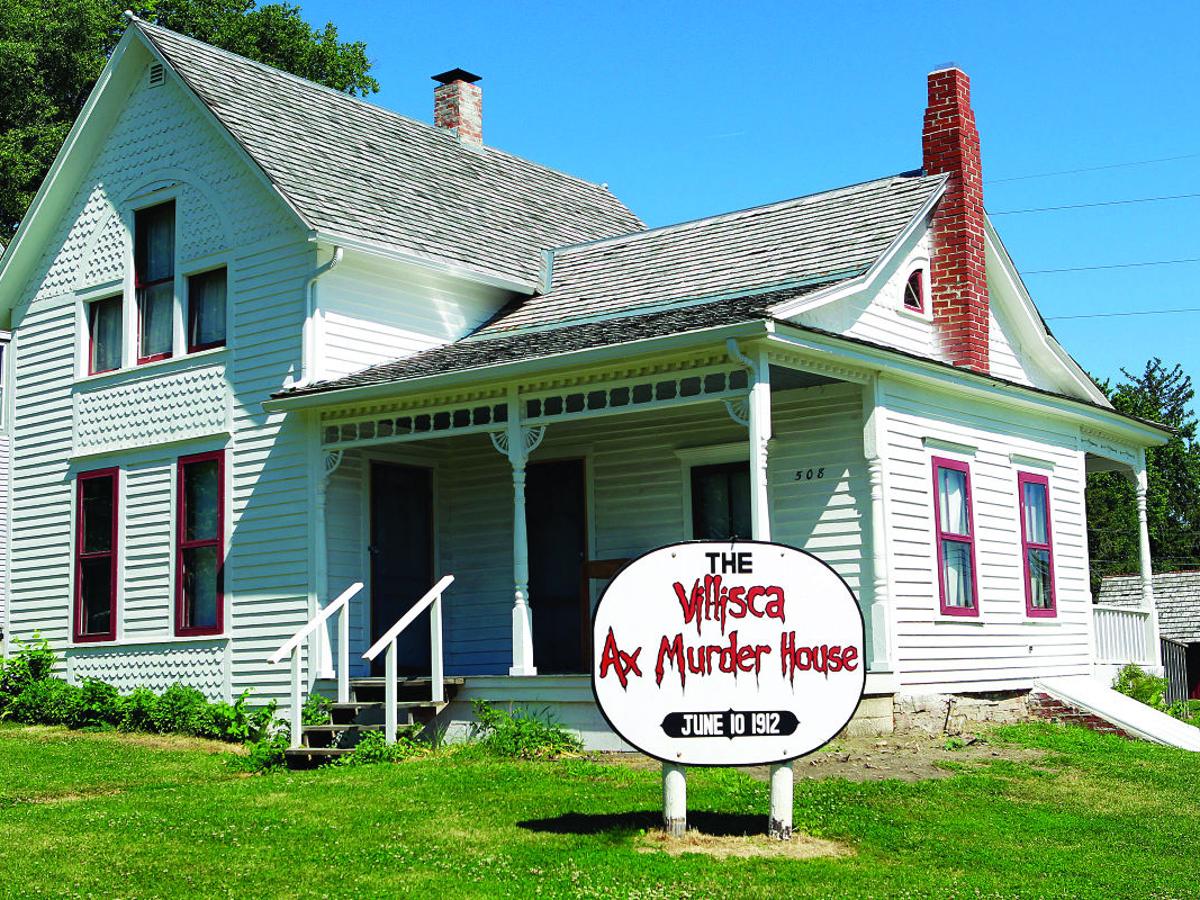The brutal Villisca Axe Murders took place in the small town of Villisca on June 9, 1912 when Josiah Moore, Sarah Moore, their four children and two children from the Stillinger family were found axed to death. The bodies of the eight victims were discovered on the morning of June 10 by Josiah’s brother Joe after he was alerted to the Moore family’s inactivity.
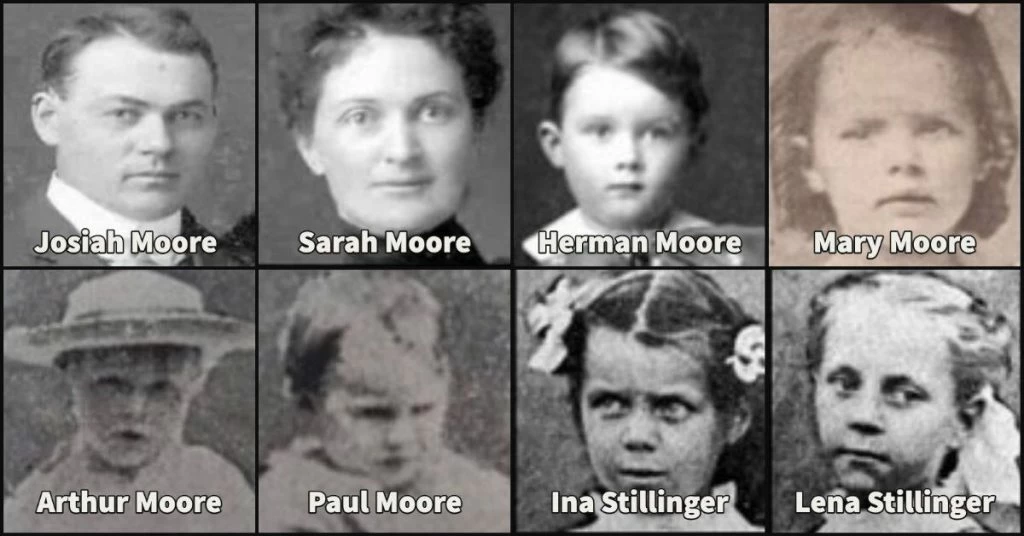
The body of the two child guests Ina (aged 8) and Lena (aged 12) were found in a bedroom at the back of the house. Both were battered beyond recognition. Defensive wounds found on Lena suggested that she may have been the only one who was awake at the time of the attack. The murder weapon, a blood-covered axe belonging to Josiah Moore was found in the girls’ room.
On the second floor, the four Moore children—Herman (aged 11), Katherine (aged 10), Boyd (aged 7), and Paul (aged 5) were found dead in their respective bed; they were bludgeoned to death in a similar fashion as Ina and Lena. It is estimated that each child received a minimum of 20 blows by a blunt object.
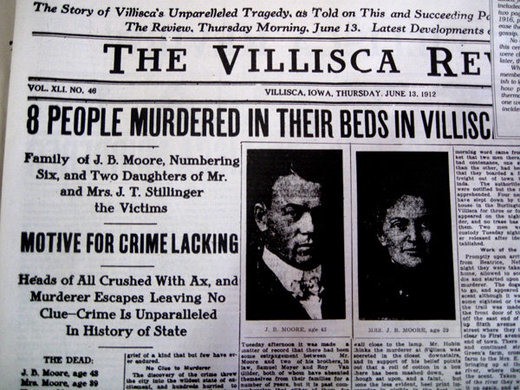
The owners of the house, Josiah and Sarah Moore were similarly found dead in their bedroom. Josiah in particular, was the only victim killed with the blade of the weapon. That said, the faces of all the victims were reduced to nothing but a bloody pulp, suggesting the savageness of the murderer.
Interestingly, all eight bodies as well as mirrors in the house were covered in sheets or clothing. This was said to be a physiological behavior of certain murderers who would go to great lengths to avoid any eye contact with the victims for fear of being ‘conscious’ of his presence. Psychologist have also posited that covering the faces of victims may have been an act of remorse, suggesting that the murderer may be familiar, or held a close relationship with the victims. Others reported that this was a superstitious act done to prevent the souls of the victims from being trapped in the mirrors.
The gruesome crime shocked the small community and drew nationwide attention. The investigation that followed was hampered by the lack of forensic technology available at the time, albeit several suspects were identified.
Theories of Villisca Axe Murders
The most popular theory suggested that the murder was instigated by Frank Jones, a businessman who runs the Jones Store in Villisca and is known to be the most powerful man in town. Josiah Moore had worked under Frank Jones for almost a decade and togther, they had turned Jones Store into a major success. However, Josiah left Jones Store and started his own business, competing directly with Frank Jones. Rumours grew that Frank Jones, who was then an Iowa State Senator, paid for the killing of the Josiah Moore and his family. An alternative version of the story suggest that Josiah had an affair with Jones’ daughter-in-law albeit it was unfounded.
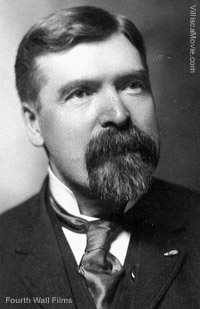
No charges were ever filed against Frank Jones due to a lack of evidence. However, townspeople of Villisca were well aware of the riff between Frank and Josiah. For most, Frank Jones is the murderer.
Another theory hinted that the murderer was simply a vagrant looking for food and money. When the murder was discovered, all windows in the house was found shut while a plate of uneaten food and a bowl of bloody water was left on the table.
The biggest theory put forward a theory that the father was the murderer. As the supposed face of Josiah Moore was mangled beyond recognition, it was assumed by the investigators that the body was indeed Josiah. Theorists suggested that the man found dead in the bedroom may have been a transient who was lured into the house by Josiah under the pretence of offering him food or a job. It was said that Josiah Moore was tired of taking care of the family and sought for a new life outside of Villisca.
Villisca Axe Murders Suspects
The only suspect ever charged in court was Reverend Lyn George Jacklin Kelly. Reverend Kelly, a traveling minister who was at Villisca at the night of the murder, has shown a fascinating interest in the Villisca murders and wrote extensively to the police to inquire about the case. It was also reported that on the morning train out of Villisca the day after the murder, he told passengers onboard (hours before news of the murder were broke to the public) that eight bodies were lying dead in Villisca.
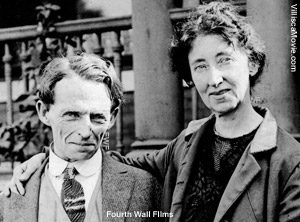
However, he was only arrested three years after the Villisca Axe murders. In spite of his confession where he alleged that God told him to “slay utterly the children”, the trials of Reverent Kelly ended in a hung jury—a situation where there are insufficient jury voting one way to reach the required supermajority— and subsequently an acquittal.
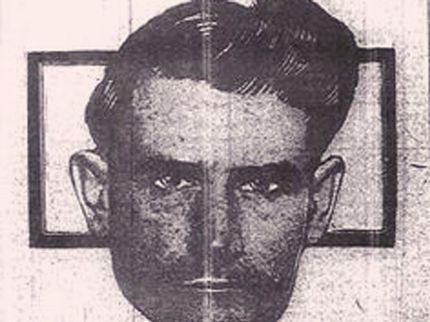
Another suspect of the Villisca murders is Henry Lee Moore, a serial killer who murdered his mother and grandmother months after the Villlisca case. As the killing was done in a similar fashion, many credited the Villisca murders as well as a host of other similar axe murders in the area to Henry. However, as there was insufficient evidence to file a charge against Henry, his case was dismissed.
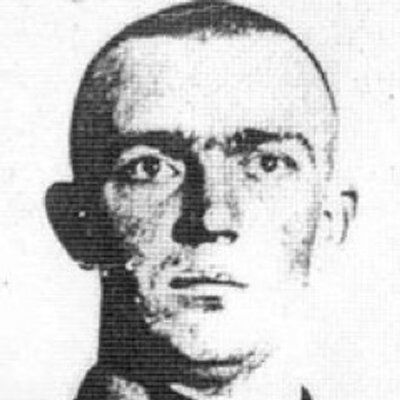
Last but not least is William “Blackie” Mansfield, a serial killer rumoured to be hired by Senator Jones to murder the Moore family. Similar to Henry Lee Moore, William was suspected being the perpetrator of the Villisca murders due to manner in which he had committed his killings; William killed his wife, infant child and parents-in-law with an axe in 1914, two years after the Villisca murders. William was brought to court in 1916 for the murder of the Moore family but was released soon after due to an alibi that verified his presence in Illinois at the time of the murder.
Villisca Axe Murders Bacon
At the crime scene, a two pound block of bacon was found leaning against the wall in the Stillinger girl’s room. Another two pound slab of bacon was found in an icebox in the kitchen. It was theorised that grease from the bacon found in the room was used as a lubricant; Lena was found with her undergarments removed, suggesting that the murderer may have sexually assaulted her before bludgeoning her with the blunt end of the axe.
However, autopsy reports revealed that there was no signs of any sexual abuse on Lena.
Another myth regarding the presence of the bacon in the room says that the meat was meant to attract and confuse any bloodhounds that may be involved in the investigations. This was proven to be false as meat was often used in the training of bloodhounds, and that rubbing grease onto the legs or body may in fact aid the tracking of the killer.
Ghosts of Villisca Axe Murders
Over a hundred years later, the Moore family house remains a part of the quiet residential street in small town of Villisca. However, unlike all other modern houses in the area, the Moore family house has maintained its early 20th century facade. The house, bought over by Martha Linn in 1994, was stripped of all electricity and plumbing to ‘restore’ the property to its 1912 condition.
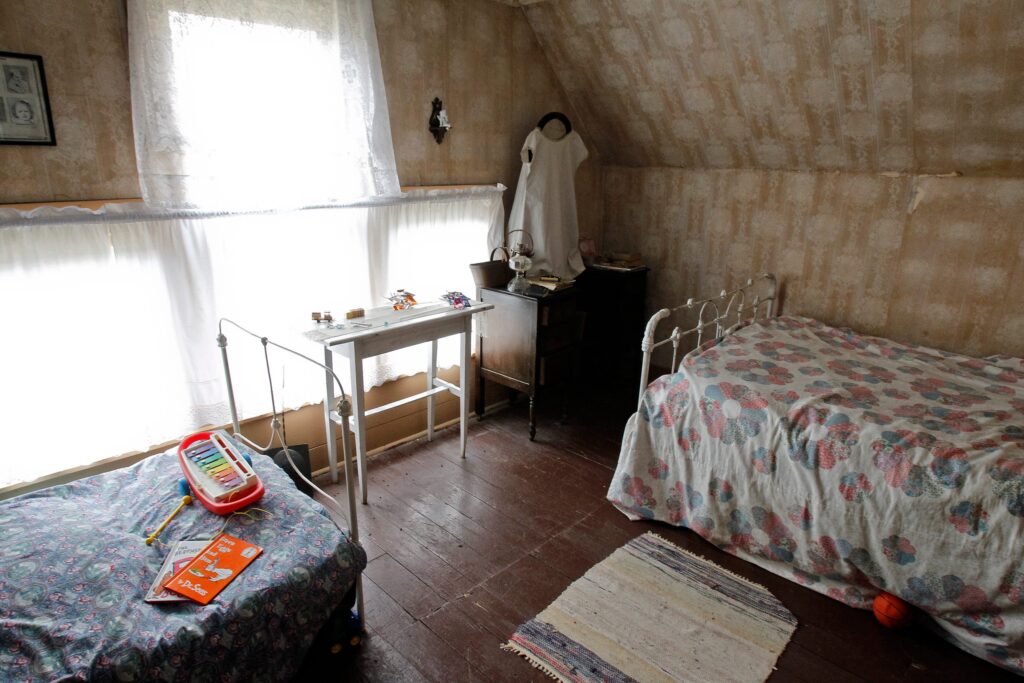
Today, the house is a local tourist attraction and favourite spot for paranormal investigators. It is believed that the spirits of all eight victims continue to dwell within the Moore family house, waiting for the day when the murderer is apprehended.
In particular, the room where Lena and Ina were murdered is said to be the most haunted room in the house. Visitors spending the night at the house claimed to have heard footsteps on the steps and seen balls and toys (left by other guests) moving on its own.
On November 2014, Robert Steven Laursen Jr and his group of friends spent the night on the Moore family house to conduct aparanormal investigation. In the middle of the investigation, Laursen who was alone in the northwest bedroom, paged for help. He was found stabbed in the chest and lying on the floor. He was immediately sent to a nearby hospital where the doctors determined that it was a self-inflicted wound. Laursen have since made a full recovery but declined to reveal what had happened on the night of the incident.
Was the Case Solved?
As of March 2023, the brutal crime that occurred in 1912 remains unsolved. This is largely due to a host of factors such as a lack of forensic technology back then, contamination from the crime scene, as well as the passage of time that has complicated the investigation.
That said, the case has continued to be a topic of speculation and fascination among true crime enthusiasts and historians. In fact, several books, documentaries and podcasts have been published on the topic of the Vilisca Axe murders.
The house continues to draws tens of thousands of visitors every year, giving visitors a chance to learn more about the crime and the victims. The popularity of the house as a tourist attraction has been controversial, with some people arguing that it is disrespectful to the victims and their families to profit from their tragedy. Others argue that the house serves as a reminder of the brutality of the crime and the importance of justice, and that it is an important part of the town’s history.

